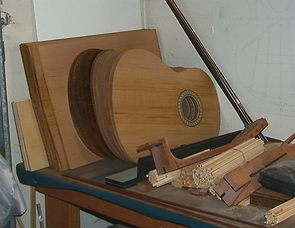


I am often asked why I usually use Cocobolo rosewood instead of Brazilian rosewood to build my instruments and the answer I always give is: "I believe that Cocobolo rosewood is the best wood for achieving the quality of sound that I am after in, most cases!"
In my opinion, Cocobolo produces, more of a brilliant and clearer sound than Brazilian or Indian rosewood. Cocobolo is the densest and least porous of these three traditionally used rosewoods, approximately 1/3rd denser than Brazilian and almost 2/3rds denser than Indian. Density factors: (Cocobolo, 950 - Brazilian, 730 - Indian, 650). From my experience, the density seems to be a factor! Another wood I'm fond of is Ziricote, very striking in appearance with a rich tone. The sound quailties seem to be somewhere inbetween Brazilian and Cocobolo.
All of these rosewoods are excellent for building classical guitars and each of them have a sonorous quality that best suits the luthier that will prefer one over another. For example, Jose Romanillios prefers Indian rosewood for building his instruments, I believe most aficionados are acutely aware of his success.
One more question I am often asked is, why do I use laminate on the inside of the ribbs (sides). I believe that to build an instrument that has the optimum amount of volume and sustain it is critical that the ribs be as ridged as possible while being at the same time as light as possible. Thus, almost all of the sonority is focused on the sound board and back, not being absorbed in the ribs. Most of the rigidity comes from the laminate that joins the rosewood and very thin leaf of maple. I don"t laminate all guitars! It is important to understand the wood your working with and exactly what you are wanting to achieve. Using a laminate or not using it on a spacific guitar will create completley different results.
Body
Philosophy Woods Finish
Soundboards
Here are some of my thoughts on some of the differences between spruce vs. western red cedar. In the old days if a classical guitar wasn't built with european spruce, it wasn't considered a real guitar. Thank God for Jose Ramirez! (For those of you who don't know, he largly introduced western red cedar to the classical guitar world as Andres Segovia played one of his guitars).
In a nutshell, western red cedar develops a note quicker than spruce, usually more volume and usually a higher celling, a tonally complex polyphonic type of sound. It also will develop it's voice sooner than spruce. European spruce has a tighter more focused monophonic type of sound and can take much longer to develop it's voice. Engelmen spruce I have found is a wonderful medium between the two. It has much of the same qualities as western red cedar, very warm and dark. Another spruce I like to use is Sitka. In the hands of a gifted luthier, these three woods sound beautiful!

Philosphy
I could spend a long time here trying to explain some of my understanding of acoustics and how I try to control it. However, for the most part, much of the acoustics concerning the art of luthiery is a feel or intuition a luthier acquires through experience and time. I have heard one luthier explain his belief in achieving a desired result, and another luthier almost completely contradict to achieve the same goal. This is not to say that one is right and the other is wrong, both were able to achieve there goals. This further confirms to me that there are ten thousand ways to build a guitar!
One thing I have found to be characteristic of a gifted luthier is that he is very consistent in the quality of sound that he gets. You know what to expect if you buy an Ignacio Fleta, Miguel Rodriguez or a true Mariano Tezanos Ramirez. With my guitars you can expect the same consistency. Of course, no two guitars will ever sound exactly the same even though they were built side-by-side with the same woods. Each of my guitars will have its own personality. Stringing up the guitar and hearing the beautiful voice is one of the truly gratifying pleasures I look forward to each time I complete a new instrument!



I french polish my guitars with shellac. This process if properly applied to a well made instrument allows it to sound as transparent as possible and in my opinion will enhance the quality of sound. French polish validates a fine classical guitar in every way, it has a look and beauty that says hand made with great care.



